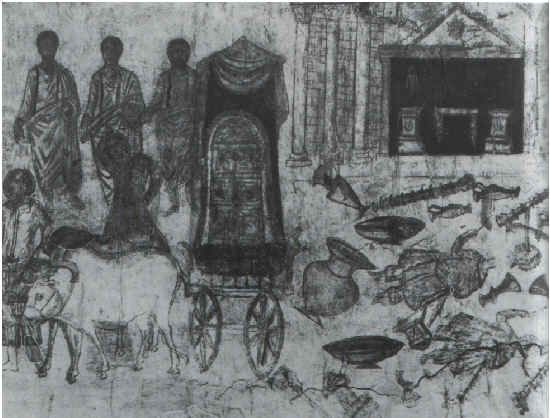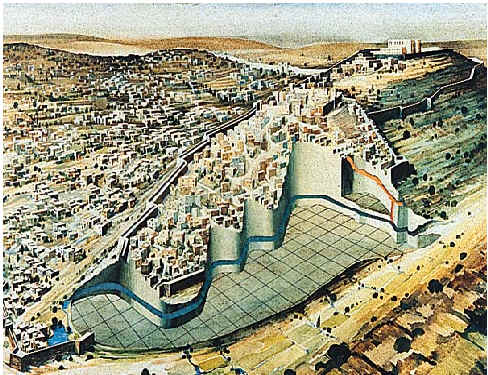|
|
|

PART II
The Ark is taken from Shiloh during a campaign against the Philistines, who had invaded Canaan from the North. The Israelites had not been able to defeat them, so the elders decided that the Ark SHOULD BE BROUGHT INTO BATTLE. The Power of God , who lives between the cherubim on the Ark, would surely be able to secure victory.
The sons of Eli therefore carry the Ark from Shiloh, and when the Philistines hear a great shout of joy from the Israelite camp, they realize that the God of their enemies has arrived. Although they understand it to be a serious threat - this was the God, after all, who had caused such havoc in Egypt - their fear causes them to fight with desperation, to avoid being enslaved by the Israelites.
They fight with such ferocity that they WIN the battle. NOT ONLY THAT , THEY CAPTURE THE ARK AND KILL THE SONS OF ELI .
The ark was later recovered and placed in the house of ABINADIB at GIBEAH, but the Tabernacle remains at SHILOH. The fate of Shiloh is never mentioned in the historical books, and although the prophet Jeremiah refers to its destruction on three occasions, he never speaks of the Tabernacle.
According to the First Book of Chronicles, the Tabernacle was located at the "high place" of GIBEON. When David brings the Ark to Jerusalem and places it in a NEW TENT, he sends ZADOK the priest to GIBEON to perform sacrifices at the Tabernacle in accordance with the regulations given in the Book of Leviticus.
In the accounts provided by the Chronicles and by the First Book of Kings, when
Solomon dedicated the Temple in Jerusalem, the priests and the Levites:
"BROUGHT UP THE ARK OF THE LORD, THE TENT OF MEETING, AND ALL THE HOLY VESSELS THAT WERE IN THE TENT." After the repairs to the Temple and the renewal of worship by the Judean King Hezekiah in the VIII B.C., there is no further mention of the Tabernacle in the historical books.

Let's go back to see how David brought the Ark from KIRYATH-YEARIM to Jerusalem. It was not carried, but placed in a cart drawn by oxen, just as the Philistines had done when they returned it after pestilence afflicted their people and the statue of their god Dagon had been shattered. Dancing and singing before the Ark, David and all the house of Israel are obeying none of the requirements of the Priestly Ark. But when the oxen that are yoked to the cart stumble and UZZAH, the brother of the consecrated guardian, reaches out to steady the Ark, he dies immediately. Not surprisingly, David "WAS AFRAID OF THE LORD THAT DAY".
Uncertain if he should bring the Ark inside the walls of Jerusalem, David leaves the Ark at the house of Obededom the Gittite. For the next three months, Obededom and his family prosper in the most spectacular manner. It seems that danger has been averted; the presence of the Ark will mean life for Israel rather than death.
David decides that it is safe to bring the Ark up to the city, he slaughters animals in sacrifice, and the people sing, blow horns and dance with joy.
In the Second Book of Chronicles, David remarks that he intended to build a house of rest for the Ark of The Covenant of the Lord, and for the footstool of God. He even made preparations for building, but God told him that he could not build a house for the divine name. DAVID WAS A WARRIOR AND HAD SHED BLOOD.
At the end of time, as the dead awake from the grave, they will look across the Valley of Kidron to the Noble Sanctuary, where the Temple of Solomon once stood. Within the Temple, the Ark of the Covenant and the Presence of God had lived among the Chosen People, but for almost 2000 years, no trace of them has been seen in the Holy City. On the Temple Mount today, the most beautiful shrine of Late Antiquity marks the triumph of another Chosen People, the lineage of Ishmael, whose prophet ascended to heaven from the Rock on which Solomon had placed the Ark.
In the Bible, the story of the Temple begins with the accession of King Solomon. His father David, the beloved of God, was growing old, and as his death approached, he assured Bathsheba that Solomon would inherit the throne.
Solomon was therefore taken to GIHON, riding on a mule belonging to his father, and when they arrived, Zadoc the priest
anointed the young man with " THE HORN OF OIL FROM THE TENT". The account is difficult to understand. We are never told why GIHON should be chosen as the site for the
anointing, and it is hard to imagine why the holy oil needed to prepare a king to rule over Israel, should be placed in a tent at Gihon, which we otherwise know as a spring outside the walls of Jerusalem.

COULD THIS HAVE BEEN THE TENT THAT DAVID ERECTED WHEN HE BROUGHT THE ARK OF THE COVENANT TO HIS NEW CAPITAL? Could the Tabernacle itself have been at Gihon? The site is NEVER mentioned as a sanctuary, however, and it seems to have nothing to do with the Ark of Tabernacle. In an attempt to solve the puzzle, scholars have suggested that the name might simply be a corruption for GIBEON, where the Tabernacle was kept after the Ark had come to Jerusalem, and where God would later appear to Solomon in a dream. This is little more than a guess, however, and the mystery remains.
(to be continued...)
![]()